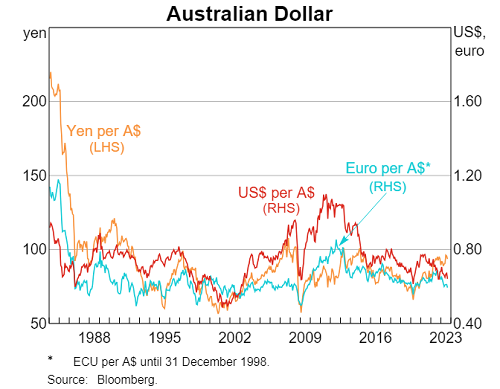A growing number of Australians are investing in global equities, largely thanks to the wide array of locally listed Exchange Traded Funds (ETFs) that make it easy to tap into offshore markets. In August 2023 for example, according to Australian Securities Exchange (ASX) data, close to $200 million flowed into ETFs in the global equity category.
Around half of those inflows were into products that are hedged (or tied) to the Australian dollar instead of to the currencies that underlie the international equities within the ETF (unhedged). In other words, the investors behind those inflows had opted to neutralise the potential impact of future foreign currency movements on their investment to remain in Australian dollars.
Currencies can be volatile
While sharemarkets can be highly volatile from day to day, so too can currencies in response to economic factors and geopolitical events.
Keep in mind that the Australian dollar was trading above US70 cents in late February this year and has since dropped back to its current trading level of around 64 cents. A decade ago, it was trading above parity with the US dollar, or about 30% higher than now.

It's anyone’s guess whether the Australian dollar will hold its ground against other currencies, move higher based on more positive domestic economic news, or drift lower again as other world economies accelerate their own economic recovery phases.
Many global ETFs offer both hedged and unhedged versions of the same fund. There’s no right or wrong choice. It comes down to personal preference, but the ongoing effect of currency movements on international assets is often overlooked by investors. And that’s where currency hedging really comes into play as a strategy.
How currency hedging works
Currency hedging involves fund managers using forward exchange rate contracts to effectively lock in fixed currency rates on a rolling basis, to remove the impact of foreign currency fluctuations on the value of non-Australian dollar assets for an Australian investor.
Think of hedging as being similar to converting your Australian dollars into US dollars before you head to the United States, for example, because you want to lock in the current exchange rate in case the Australian dollar drops further in value before you take off for your holiday. It’s a form of insurance policy.
Buying that insurance typically comes at a cost. Hedged investment products often have a slightly higher management fee than unhedged ones.
The cost of hedging and the risks associated with execution are small, but the impact hedging can have on your portfolio can be significant depending on the relative movements in markets and currencies.
The right strategy for you
A good framework for reviewing whether or not to hedge your currency exposure is to consider first your appetite for risk and your investment time horizon and then to understand the individual nuances of exposures to international equities and bonds.
If you have a long way to go to retirement, you may be comfortable taking on the currency risk and accept the short-term currency volatility that unhedged exposures to international shares can bring.
Vanguard research studies have shown that currency movements tend to be neutral over the longer term.
Using hedging to screen out the currency fluctuations that affect international asset prices can be beneficial for investors seeking less volatility in the asset value.
Those closer to retirement, and those who are just more risk averse than others, will likely have a greater allocation to fixed income (bonds) already. Bonds are an effective ballast against equity market declines, and international bonds are no exception.
Currency hedged gains can also result in higher taxable distributions, so investors in hedged products should expect higher than average distributions.
It is generally accepted that in order to maintain international bonds’ defensive characteristics in a portfolio, they should be hedged, as their benefits could otherwise be overwhelmed by currency movements.
The decision on whether to hedge international equity exposures is not so straightforward, however.
Consider when global equity markets fall, and the Australian dollar weakens. If unhedged, you may experience smaller losses than a hedged portfolio. If the opposite scenario unfolds (markets rise and the dollar strengthens), the hedged portfolio appears ‘better’ than the unhedged version.
Currency movements, and how they move with equities, are difficult to predict, so investors should treat currency hedging as a way to manage risk, not to add return.
Duncan Burns is Chief Investment Officer for Asia-Pacific at Vanguard Australia, a sponsor of Firstlinks. This article is for general information purposes only and does not consider the circumstances of any individual.
For more articles and papers from Vanguard Investments Australia, please click here.